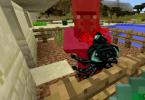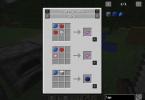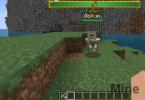In the laboratory of the Master's Secret, another sample of weapons has been built - a rubber-shot pistol. The toy compares favorably with other previously built models with its multi-charge and the presence of the sound of a shot.
How to make a rubber-shooter pistol with your own hands
The finished development of the Parabellum pistol model was taken as a basis. The repetition of the pistol in comparison with the previous one (to watch for everyone who makes a rubber-shooter for the first time) turned out to be not very difficult, although one detail had to be redone, having clarified the drawing. The material of construction is simple - trimming of planed boards with a thickness of 15-20 mm, pieces of five-layer and three-layer plywood. You will also need: a piece of metal rod or nails with a diameter of 3-3.5 mm, six small screws or self-tapping screws with a countersunk head, PVA glue and a spring from a fountain pen. The tool for work is a jigsaw, a drill with a set of drills, a clamp, medium-grain sandpaper, a screwdriver, a metal saw or wire cutters.
Diagram of the manufacture and assembly of a rubber-boom
- Download and print the blank. Link at the end of the instructions. We cut out the templates of the parts not along the contour and glue the patterns of the parts F1 (handle), F2 (trunk), F3 (stop), M2 (trigger) on a piece of board, guided by the fibers of the wood (see photo). We glue templates P1 (box wall), M1 (shutter) on a piece of five-layer plywood. Glue template P2 (overlay) on a piece of three-layer plywood. The number of cut parts P1 and P2, two pieces.
Rubber Shotgun
- We cut out the details of the rubber thrower with a jigsaw according to the templates. You have to be patient. The pistol requires precision, especially in the manufacture of moving parts of the bolt and trigger (M1 and M2). Assembly experience has shown that it is better to lengthen the trigger in the upper part by 2-3 mm. Make this mark immediately after gluing the template (see photo). When assembling and adjusting, it is better to undermine the part than to redo it. Be careful not to damage the template paper with the hole marks.
We prepare two metal axles, with a board thickness of 18 mm, the axes will be 32 mm long. The axles should be straight, and the ends should be free of burrs and irregularities.
Drilling holes should also be taken with care. Be sure to screw the centers of the holes with your own hands before drilling - with a core, an awl, a nail. Holes for fixing screws in the sides of the box (part P1) can be drilled with a 3 mm drill and the edges for the tapered head can be selected with a larger drill. Holes for metal axles (see drawing and photo) should be 0.1-0.2 mm larger than the diameter of the axle. That is, the axle should move in the hole, but not dangle.
Trigger refinement
Axle part
- We drill a hole in the rubber gun's shutter (M1), the hole diameter should be 0.1-0.2 mm less than the axis diameter. Drilling must be strictly vertical!
We drill a hole in the trigger (M2) along the diameter of the axis. You must also drill strictly vertically! If you have a drilling machine, it will help a lot.
We clean all the parts with sandpaper, the handle of the gun and the trigger hook can be given an anatomical shape, all protruding edges of the parts can also be rounded off. thoroughly clean the places where the rubber bands of the barrel and the bolt touch. Attention! Do not round off the valve points (M1)! Do not round off the upper edges of the trigger! If you are going to make a masterpiece, then you should consistently process the outer parts with sandpaper with a decrease in the grain number.
The trigger piece (M2) must rotate freely in the future box, therefore, its thickness must be reduced by 1-1.5 mm. This is done by sanding down the side surface with sandpaper.
We insert the axle into the trigger of the crossbow and with light hammer blows we insert the axle into the bolt (M1)
We put one pad on a flat surface and place the parts of the handle and barrel and the stop of the pistol and check the operation of the mechanism (watch the video). The handle should take its position and not interfere with the operation of the shutter and be a stop for the trigger in the extreme position of the shutter release. The barrel should also be a limiter for the movement of the trigger when the shutter is released. When cocked, the bolt must rest on the trigger plate. Understand and understand the work of the mechanism so that the actions for further work are conscious. Sharpen the bolt support pad on the trigger, if necessary.
With a pencil, mark the position of the handle, barrel and stop on the side of the box. We cover the parts to be glued with PVA glue and, with the help of overlays, glue the rubber-barrel handle, the box wall, the barrel and the stop together in the designated places. The parts are tightened with a clamp until the glue is completely dry. Make no mistake about the correct arrangement of the parts!
Wall marks
Bonding parts
- After gluing, we re-insert the moving parts and check the operation of the mechanism. To return the trigger, a spring must be installed. For this, a hole is drilled in the trigger with a depth of 4-5 mm. We insert the trigger with the spring into place))). If necessary, shorten the spring a little. Tests have shown that the spring from the handle constantly wants to pop out; for this, a small indentation was made manually on the barrel stop (see photo), which solved the problem.
We install the second wall of the crossbow cover. After installation, the shutter should be located without distortions and rotate without much effort, and the trigger freely return to its original position after pressing. If this does not happen, eliminate the cause, it may be necessary to cut out a new wall if the holes are not made accurately. Holding the wall with your hands, check the operation of the mechanism for all four positions of the shutter. Remember the position of the wall.
Fasten the second wall with screws. In order to avoid cracking of parts, you can drill parts with a thin drill of 1.5-2 mm. Perform control four shots. Does the rezinkostrel shoot? Hooray. Install the screws on the first wall.
Stick on pads to cover the bolt and trigger pins.
Parts glued
Checking work
Spring hole
And, it's time to make a new shooting device, which probably none of your friends have. Therefore, read the article to the end and find out how to do rubber band gun.
Making a pistol shooting with rubber bands
To make this homemade pistol (see also "") you will need 3 barbecue skewers, three wooden clothespins and two plastic ones (you can easily replace them with wooden ones), three rubber bands, a sharp knife, pencil, glue gun (you can replace it with wood glue and plastic, although this will increase the time for making a homemade product).
- First, we glue the existing skewers together.
We glue three skewers
- We glue one wooden clothespin from one edge of the skewers and strengthen its fastening strength with an elastic band. At the second wooden clothespin, cut off the edges of 10 mm and 5 mm, as shown in the figure, and glue it to the first clothespin.

Glue the first clothespin
- We disassemble the third wooden clothespin and cut off a piece on one side.

Glue the second clothespin

Cut off the edge of the clothespin
- We glue half of the clothespin to the skewers.

Glue half of the clothespin
- From the second part of the clothespin, we will make a base for making a pistol grip. To do this, glue it under the clothespins.

Making a pistol grip
- We make the handle of a homemade pistol from plastic clothespins. Having disassembled the clothespins, glue them as shown in the figure.

We glue the handle made of plastic clothespins
When the pistol shooting with rubber bands dries up, you can start shooting at targets. To do this, we load it - we stretch the elastic bands, inserting one edge into the slot on the trunk, and the other into the clothespin.

An easy-to-make pistol shooting with rubber bands was made by the author of a homemade product. The main criterion in its manufacture was simplicity and semi-antique style. For its manufacture, the following were needed
Tools and materials:
-Pin;
-Wood dowel;
-Board;
-Two screws;
-Dremel;
-Glue gun;
Step one: the handle
First, the author drew a sketch of the handle on paper. The angle between the plane of the barrel and the trigger should be 45 degrees. Then I cut out a template from the cardboard. Using a template, I cut out the handle of the rubber-boom from the board. Sanded it with a Dremel.

Step two: assembly
I cut off one leg from the clothespin and glued it, with hot melt glue, to the handle. Made in a dowel, from the end, washed down. I glued it to the upper plane of the handle.

Step three: painting
Painted the gun. I screwed in two sighting screws from the top of the barrel.

Now you can test the rubber-boom. Insert one end of the elastic into a clothespin. Pull the other end onto the dowel, fixing it in the groove. We pull the trigger. Pli.


Especially for our office friends, I will tell you how you can replace parts of a pistol. The handle can be made of cardboard, the barrel is made of a pencil. An office clip can be used instead of a clothespin. And fasten it all with tape. Well, you do not need to replace the rubber band, it is in any office.
Choose a piece of wood suitable for the body of the gun (barrel and stock). It should be wood that is soft enough that you can cut grooves in the barrel of the rifle. Regular wood is the cheapest and most readily available material, although bamboo or other materials can also be used for the barrel.
- The stock should be about 60 centimeters long.
- Suitable wood for the hull can be cut from a fairly hard branch, plank or plank.
- Wooden tool handles from hardware stores are also great.
Collect the rest of the parts needed for the gun. In addition to the barrel and stock, you will need a trigger and something you can use to attach it to the body of the gun. Thus, you will need:
- Clothespin (as a trigger)
- Pencil
- Glue (for wood, superglue, etc.)
- Elastic
Attach a clothespin to the body - this will be the trigger. The best place for your clothespin is determined by the type of gun you want to make. To make the gun more powerful, attach the clothespin closer to the rear edge of the body. For a conventional shotgun, attach a clothespin ⅔ from the front edge of the barrel. Do it like this:
- Mark the future location of the clothespin with a pencil or knife.
- Glue the clothespin to the body using wood glue, super glue, or hot glue.
- Wait for the glue to dry completely.
- Note: The farther from the front edge of the barrel you place the clothespin, the tighter the elastic will stretch. If you stick the clothespin too far, it may not be able to hold the elastic and it will slip out of it.
Make an incision in the front of the trunk. Using a knife or other cutting tool (such as a small wood carving file), cut a groove in the front end of the trunk. This groove is where you will insert the elastic.
Load your gun. Take the rubber ring and insert one end of it into the groove you cut in the front of the barrel. Then pull the free end of the elastic back to the clothespin. Open the clothespin and:
- Pull the elastic a little more so that the end is behind the front teeth of the clothespin.
- Snap on the clothespin by holding an elastic band in it.
Check if the elastic is tight and secure. Pull the elastic slightly with your fingers to make sure that the notch in the barrel is deep enough to prevent the elastic from slipping out of the barrel. Then test the clothespin making sure it is held securely in place.
- If the rubber band easily slips out of the groove in the barrel, deepen it slightly.
- If the clothespin moves under the influence of the stretched elastic, secure it more securely with glue or tape.
Our creation is a pistol made of plywood that can shoot rubber bands for money.
You can fire up to seven shots without reloading. The aiming range is three meters, and the rubber bands fly away at a distance of up to ten meters.
The pistol duplicates the well-known Desert Eagle caliber 50. You experience something special when you hold it in your hand.
We have produced a series of "Boomstarter" products, each with an engraving of the same name and a unique serial number.
First 50 sponsorswill receive pistols of this series for only 500 rubles.


You can make the pistol a personal accessory.

You can order any inscription and we will engrave it for you! And when you get the gun in your hands, you can give it the look you want by treating it with paints, a soldering iron or a burner!
This is not just a toy - it is a useful toy.
Improves team atmosphere and relieves stress
Instead of long conversations or long silences, a good office shootout.
Saves health from tobacco smoke
Instead of a smoke break, there was a rubber band shooting competition.
Improves office discipline
Instead of punishment, the boss shoots a negligent employee. You can publicly.
Eliminates conflicts
A few shots are enough - and the irritation evaporates. The conflict is self-destructing.
Ideal as a gift for an expressive girlfriend or boyfriend
Allows you to express your feelings without words - with shots.
We and our laboratory.
The pistol was designed and manufactured in the laboratory of robotics and 3D-design for teenagers "Kosmoport".

We are engaged in the development of complex equipment, and in addition, we conduct free classes in robotics and 3D modeling for schoolchildren in Yekaterinburg.
For our own entertainment and shooting in the laboratory, we designed and manufactured this pistol. It turned out that it is useful not only for us. We decided to start production.
All profits from the implementation of this project will go to the development of our laboratory, including the salaries of teachers. Thus, by supporting the project, you are contributing to the engineering education of schoolchildren. With us, every schoolchild in Yekaterinburg can study and implement their technical ideas for free. We provide for training all the necessary element base, materials, tools.
A trial batch of ten pistols has now been released.
The test of the product in combat conditions revealed the complete reliability of the device. The gun looks and works perfect. It was not easy to get such a mechanism to work without fail. So that the rubber bands never get bunched up, jam and fly out all at the same time. But we did it - now the gun is really reliable. To achieve this result, we used about fifteen square meters of plywood.
We have made a high quality product and we want to bring it to the market. Support our project. You will become the first owners of our creation!
Why do we need a Boomstarter?
To launch a full-scale production, a serious flow of customers is needed. Our equipment allows us to make prototypes of products, but cannot provide mass production. If we collect the required amount at the Boomstarter, then the first step will be taken and it will be possible to release the whole batch.




